This recipe for Ghanaian jollof rice brings you a brightly colored red/orange rice dish, with wonderful spice and rich and saucy beef (or other meat). Jollof rice is a much-loved festive dish that people often serve at weddings, parties, and other large gatherings. The rice cooks in a rich and spicy tomato-based sauce, giving it a bright color.
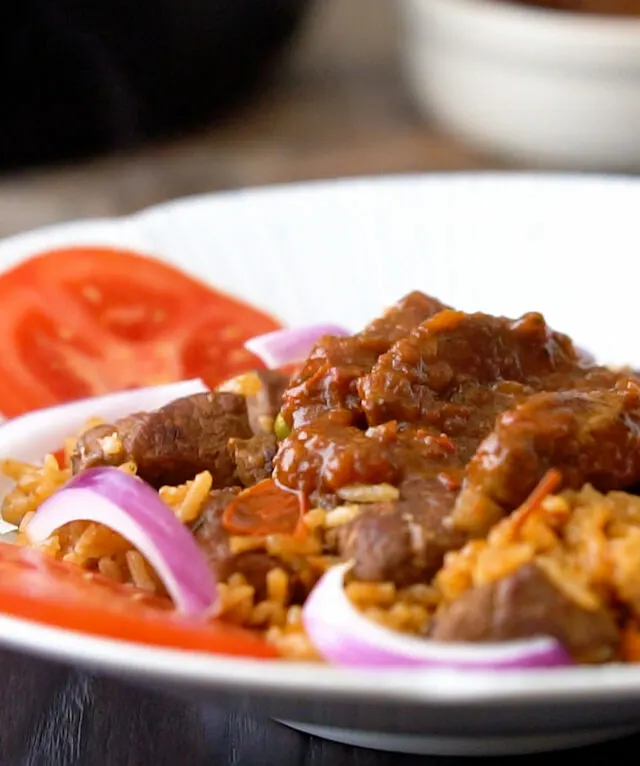
The origins of jollof rice
As much as we have prominent “jollof wars” between Nigerians and Ghanaians, all centered around who makes the best jollof rice, it actually originates somewhere else.
Jollof comes from the Senegambia region of West Africa, particularly Senegal. There they call this rice dish thieboudienne or ceebu jen. To make it they use a mixture of rice, onions, tomatoes, and fish.
How this dish then managed to lend itself to the rest of West Africa as jollof, jellof or jallof still remains a mystery.
Some think that this could be connected to the Senegalese Wolof tribe. Others have also made the connection between jollof rice and jambalaya. However, the direct connection has been heavily contested even though the dishes look similar in appearance.
I have had my own theories as to how it happened that the modern-day jollof, a rice dish filled with ingredients that are not indigenous to West Africa, came to be, which you can read about in my Party Jollof recipe.
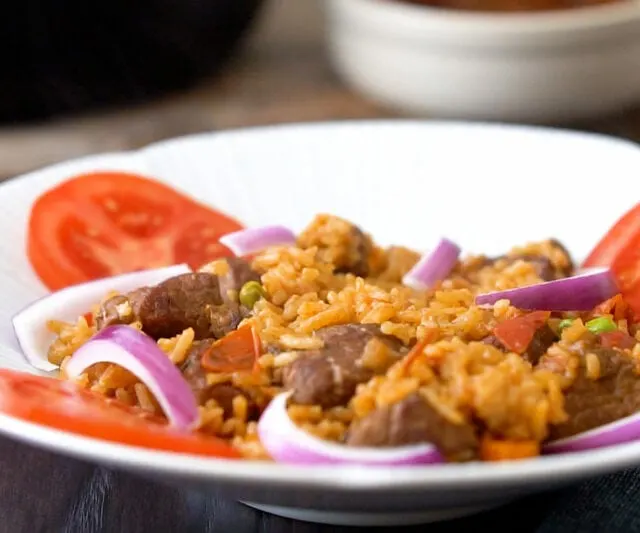
Which rice is best for jollof?
The first component of jollof is the actual rice. As we are focusing on Ghanaian jollof rice here, it pays to note that the choice of rice will vary greatly across the different West African regions.
Ghanaians are partial to long grain rice such as Thai jasmine or Basmati rice.
Nigerians prefer the plump and separated grain effect of par boiled rice such as Uncle Ben’s style rice, easy cook rice, or what we now know as Golden Sella Basmati rice. This is rice that has been parboiled in the husk before milling. The result is a stiffer grain that does not stick together when cooked.
Ghanaians pride themselves as being purists by staying away from this kind of processed rice, however the benefits of the parboiling process makes the rice easier to digest.
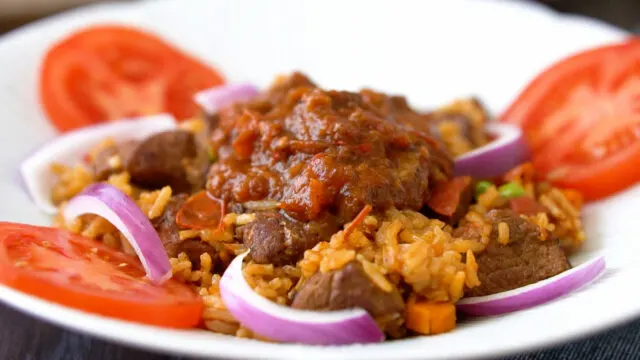
Tomato stew — a jollof essential
The second major component in jollof is the tomato stew base.
Cooks usually make the stew by frying onions and adding tomato paste or puree to enrich the sauce. Then they add tomatoes, garlic, peppers, and ginger. Once all ingredients are in the pot, they reduce the sauce to a thick and rich oily mixture.
We love observing an oil film at the top of a stew or sauce. This signals that it is ready to receive the rice and additional water for steaming.
Does jollof rice have meat in it?
Jollof can come with or without meat. But the third component of today’s Ghanaian jollof rice recipe, particular to many Ghanaians, is meat mixed into the rice.
Goat, beef, or lamb (ram meat) are common additions. (I love jollof rice with goat meat or beef.)
Jollof rice can also be made with chicken or fish.
Other modern variations have seen people mix corned beef into their rice to make an entirely delicious meal with a modern industrialized twist.
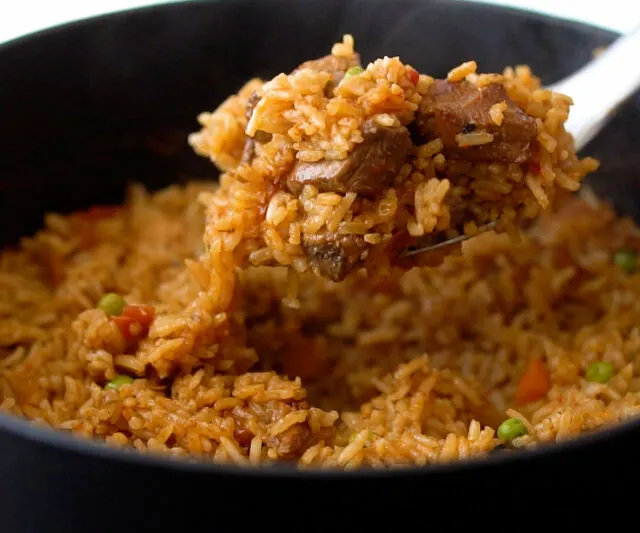
What is used to season jollof rice?
A variety of spices can be used to make this one-pot dish. I find that the choice of meat will determine the direction of spices used.
Memories of my mother’s jollof rice are filled with the rich aroma of cloves, which she would always add to her goat or beef jollof rice.
Seasonings such as bouillon cubes, chicken spice, or salt may be added, followed by dried aromatic herbs such as bay leaves, thyme, or mixed herbs.
You can now even find “jollof mix” spice blends in some stores depending on your location.
Can I add vegetables to jollof?
The final step in Ghanaian jollof rice is stirring in some mixed vegetables such as carrots, green beans, and peas.
This step may have come out of food and nutrition or catering lessons, as the result is a beautifully bright garnish, however, it is a very common step in Ghana.
Other vegetables that can be used are cabbage, aubergines (eggplant), and tubers such as cassava or potatoes. However, these are more common in thieboudienne and other Sahel regions of West Africa.
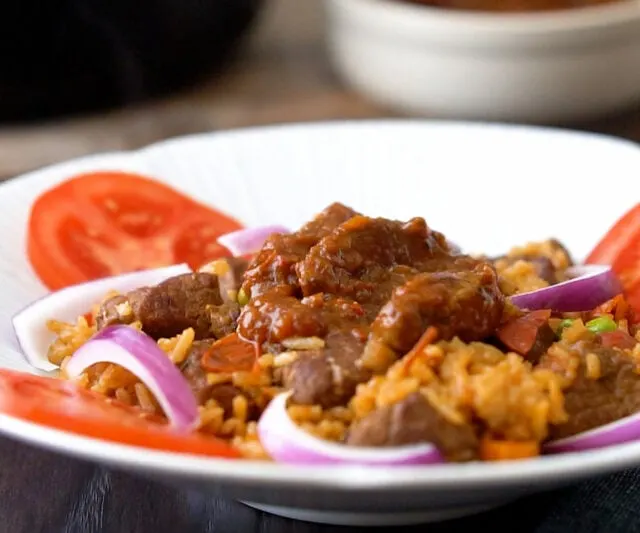
Variations of jollof in West Africa
As previously mentioned, in Senegal, the dish called thieboudienne is the national dish of the country and is considered the origin of jollof rice.
Not far away in neighboring Gambia, benachin is the thieboudienne equivalent.
When I was growing up, I remember my aunt’s benachin. She would make it with dried salted fish, which had a fermented flavour. Her’s was absolutely delicious.
Nigeria’s most popular jollof rice is known as “party jollof” in Lagos state. Party jollof is one of the most searched African food items on Google. It is often cooked in large quantities, over a wood fire and is described as having a smoky flavour, which comes from the charring at the bottom of the huge three-legged vats that caterers use.
Similar Dishes to jollof rice around the world
When cooked without meat, jollof is very much a savoury rice dish, comparable to the Portuguese arroz de tomate.
I previously mentioned jambalaya as a dish that is similar to jollof rice. It is a dish with West African and French roots.
Not far from jambalaya in America’s south, Gullah red rice is almost identical to jollof, with the addition of smoked sausage.
Jollof Rice (Ghana Style)
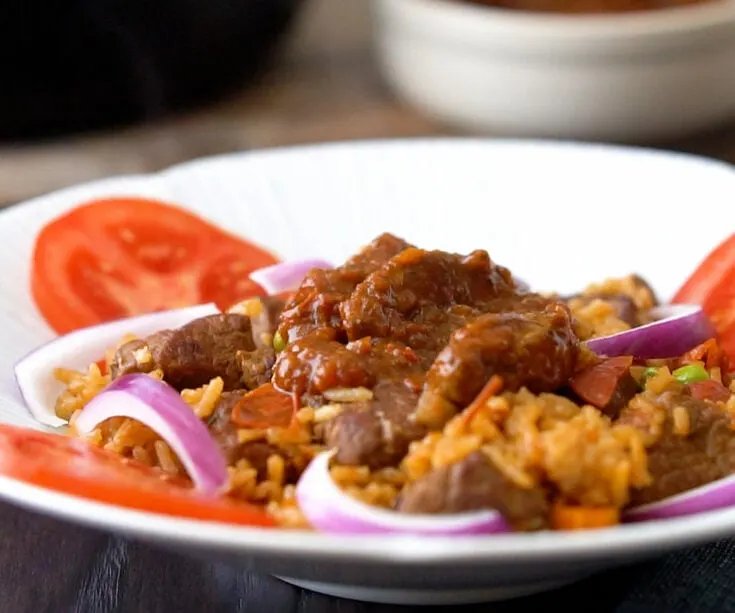
This recipe for Ghanaian jollof rice brings you a brightly colored red/orange rice dish, with a wonderful spice and rich, spicy, and saucy meat.
Ingredients
For the meat
- 750 to 800g (1 1/3 lbs) lamb (or beef)
- ½ an onion
- 1 scotch bonnet pepper (habanero is a good substitute)*
- 1 bouillon cube**
- 3 whole cloves (roughly 1/4 tsp ground)
For the rice
- 4 Tablespoon oil
- 1 large onion, diced
- 2 cloves garlic, minced
- 1 inch fresh ginger, grated
- 1 scotch bonnet pepper (habanero pepper)*, chopped
- 1 Tablespoon tomato puree (tomato paste)
- 6 large, fresh tomatoes or 1 and ½ cans of tomato, chopped
- 1 seasoning cube/bouillon cube** (or salt to taste)
- 1 teaspoon thyme
- 2 cups long grain rice (Thai jasmine)
- 2 cups hot water or stock/broth**
- ½ cup mixed carrots and peas (thawed if frozen or fresh)
- A round of parchment paper that fits inside your cooking pot (see step 11)
Instructions
For the meat
- Cut the lamb (or beef) into sizeable chunks.
- Create a paste by blending the ½ portion of onion and lamb seasoning in a food processor or with a mortar and pestle. Then, rub the paste on your meat pieces.
- If the meat is tough, simmer the meat and sauce paste until the meat is tender, then remove the pieces of meat and grill or fry them so the lamb pieces crisp up.
- If the meat is tender, it can go straight to the grill for cooking through. Set the cooked meat aside.
For the rice
- Rinse your rice and start some water boiling (for soaking the rice in step 7). (The rice is washed to remove excess starchiness, which can make the final dish gloopy or sticky.)
- To make the stew base, heat the oil in a heavy bottomed saucepan.
- Fry the onions until golden brown. Add the garlic and ginger a few seconds before adding your tomato puree (tomato paste). Fry for just under a minute.
- Add the thyme and bouillon cube, followed by the tomatoes and scotch bonnet pepper.
- Cook the sauce for about 15 to 20 minutes. Stir continuously to make sure it is not burning at the bottom.
- Next, add all the meat and stir to coat it well in the sauce. Continue cooking the stew.
- While the tomato sauce is cooking, soak the rinsed rice in some boiled water until the stew base is ready.
- Once the stew is thick, with an oily film forming on the surface, remove half the meat stew from the pot and set it aside for serving. (This is a preference particular to Ghanaians, who will often eat jollof rice with additional stew on the side.)
- Strain the soaked rice and add it to the pot. Season to taste carefully.
- Top up the pot with enough water or broth. For those with an experienced eye for rice, this would normally be about 500ml (2 cups). (You may need to add more later if the rice is still hard.) Stir to mix, then bring to a boil, then reduce to medium heat.
- Once simmering nicely and the moisture has nearly all gone, add the peas and carrots. Then cover with parchment paper right above the rice (to lock in moisture and add natural cooking pressure). Close with an airtight lid. Reduce the heat to low and simmer gently for 20 minutes.
- Taste the rice. Once the grains are cooked it is ready.
- The bottom of the pot will have a layer of caramelized jollof with concentrated flavour. For those who want a smoky flavour, raise the heat back to high for a few minutes, and allow the bottom of the pot to toast. Take off the heat and your rice is smoky and ready to eat! Washing the pot will be interesting afterwards, but nothing a good soaking can’t fix.***
Notes
*Scotch bonnet peppers are quite spicy, which will give significant heat to this dish, as is traditional. If you prefer more medium or mild food, adjust the amount of scotch bonnet pepper according to your preferences. While not traditional, a 1/2 teaspoon of paprika could be substituted for each pepper for a (not spicy) version that is more accessible to spice-sensitive palates.
**If bouillon cubes are not available, they can be omitted. If doing so, be sure to use broth instead of water for best flavor and add salt to taste.
***To help clean the pot, boil some water in the empty pot. Then let the hot water stand in the pot for 20 minutes. Scraping the bottom occasionally. This typically works quite well for getting those bits un-stuck.
Nutrition Information:
Yield:
6Serving Size:
1/6 of recipeAmount Per Serving: Calories: 245
If you liked this recipe, here are some similar dishes you may enjoy!

Freda has been a food writer for 10 years, with a significant focus on the under-explored area of African cuisines. She is now established as an African Cuisine Expert and resides in Lagos, Nigeria with her husband and 4 children. In 2018 she co-authored “The Science of Spice”, exploring the spices of the African continent. You can find Freda on her site MyBurntOrange.com.
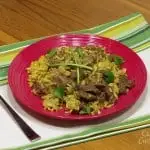
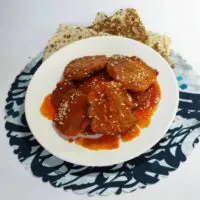
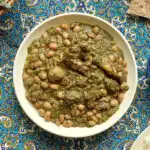
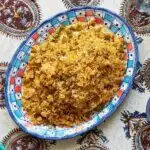
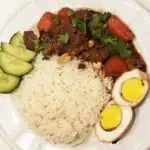
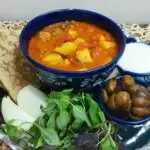

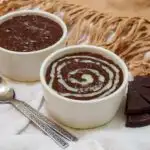
Josephine
Thursday 1st of September 2022
Hello. I'm fully Ghanaian and I know how I loved jollof, growing up. I agree the major problem is too much water. However, the type of rice used counts a lot. For example, Ofada rice and other types of hard-to-cook local varieties are not suitable for jollof. Also, the only types of rice I soak for jollof are basmati and parboiled rice. All other rice types are washed and drained. Please, in honor of our Ghanaian mamas who pride themselves in "jollofing" skills, can we ask for a repost of this recipe's photo in a more palatable way. Thank you.
Sarah
Monday 26th of September 2022
Hi Josephine. We have updated our pictures. Can you let us know if you feel that the new ones are a better representation of jollof?
Sarah
Thursday 1st of September 2022
Hi Josephine. Thank you for sharing. We will be doing some testing of Freda's recipe to see what adjustments need to be made and to update to new pictures based on your and other readers' suggestions. Best, Sarah
Kweku
Sunday 28th of August 2022
I saw the title and end product and decided to let you know this recipe isn't Ghanaian Jollof but I see some good people already pointed it out. Step 1,7,8 and 9 were off and the reason for the end product. We don't wash the rice with hot water or soak it. Rinse with tap water till the water is clear
Also IMO the only sauce allowed on Jollof rice is shito for extra spicy kick. If you're served/eat jollof rice with stew, you can't be trusted lol
Sarah
Thursday 1st of September 2022
Thank you Kweku. We will be reviewing this recipe based on your and our other readers' comments.
HannanBestman
Thursday 25th of August 2022
Freda, Ghana's joffof rice is not typically cooked with the meats in it nor mixed vegetables.
That recipe is uniquely Liberian style which the Liberians got by the way from the Portuguese Paula when Vasco De Gama and crew travelled thru Liberia. Thanks
Sarah
Thursday 1st of September 2022
Thank you for sharing Hannan.
Mike
Tuesday 16th of August 2022
Errmmm...I'm Ghanaian and apart from the ingredients being spot on, the final result isn't. It's too moist to be Ghanaian.
Sarah Ozimek
Monday 22nd of August 2022
Hi Mike. Thank you for sharing. Would you suggest less water or broth used in the rice?
Nana Ansah
Saturday 11th of December 2021
Good recipe but this definitely looks too moist. Jollof rice naturally does not need too much water since it will just retain it and then half cooks and half doesnt yet it starts burning. It is better to use 1:0.5 for rice to water ratio since the stew will also help soften the rice. If you need more water then u add it bit by bit. Also use broad wooden spatulas to prevent the rice from breaking.
Sarah Ozimek
Saturday 11th of December 2021
Thank you for those tips Nana.